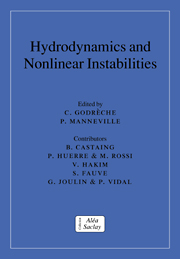Book contents
- Frontmatter
- Contents
- Preface
- Contributors
- Overview
- 1 An introduction to hydrodynamics
- 2 Hydrodynamic instabilities in open flows
- 3 Asymptotic techniques in nonlinear problems: some illustrative examples
- 4 Pattern forming instabilities
- 5 An introduction to the instability of flames, shocks, and detonations
- Index
3 - Asymptotic techniques in nonlinear problems: some illustrative examples
Published online by Cambridge University Press: 04 November 2009
- Frontmatter
- Contents
- Preface
- Contributors
- Overview
- 1 An introduction to hydrodynamics
- 2 Hydrodynamic instabilities in open flows
- 3 Asymptotic techniques in nonlinear problems: some illustrative examples
- 4 Pattern forming instabilities
- 5 An introduction to the instability of flames, shocks, and detonations
- Index
Summary
Introduction
Nonlinear dynamics is a rich subject, still only partly understood. Progress is being made in different ways through experiments, computer simulations and theoretical analysis. In this latter category, perturbation theory and asymptotic methods are classical but useful techniques. The aim is to introduce the reader to the nuts and bolts of their use. These notes correspond to an introductory course given at the Beg-Rohu Summer School in the Spring of 1991. It was for graduate students and young post-docs who were interested in theoretical computations in hydrodynamics. The emphasis is put on practical applications rather than on theory. We present, as completely as possible, several calculations on some examples that we find interesting both from a physical and mathematical standpoint. For the expert reader, we should apologize because many subtleties are left aside in these lectures. However, more thorough treatments are referred to as we proceed. Finally, this is an appropriate place to acknowledge my debt to Yves Pomeau from whom I have learned almost everything that I know in this field. I would also like to thank Claude Godrèche for giving me the opportunity to present these lectures in Beg-Rohu and even for convincing me of writing them up, all the “students” for their interest, for catamaran sailing and for sharing unexpected salted baths and crêpes which made teaching in Beg-Rohu an enjoyable experience. Finally, I am grateful to Angélique Manchon for patiently typing these notes, and to Paul Manneville for carefully editing them.
- Type
- Chapter
- Information
- Hydrodynamics and Nonlinear Instabilities , pp. 295 - 386Publisher: Cambridge University PressPrint publication year: 1998
- 11
- Cited by

